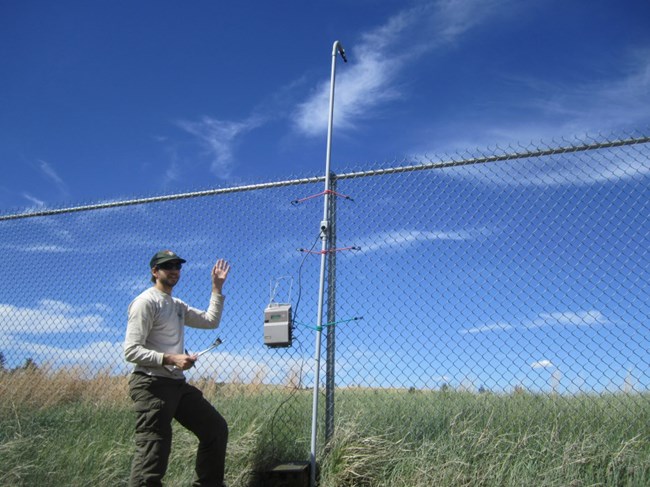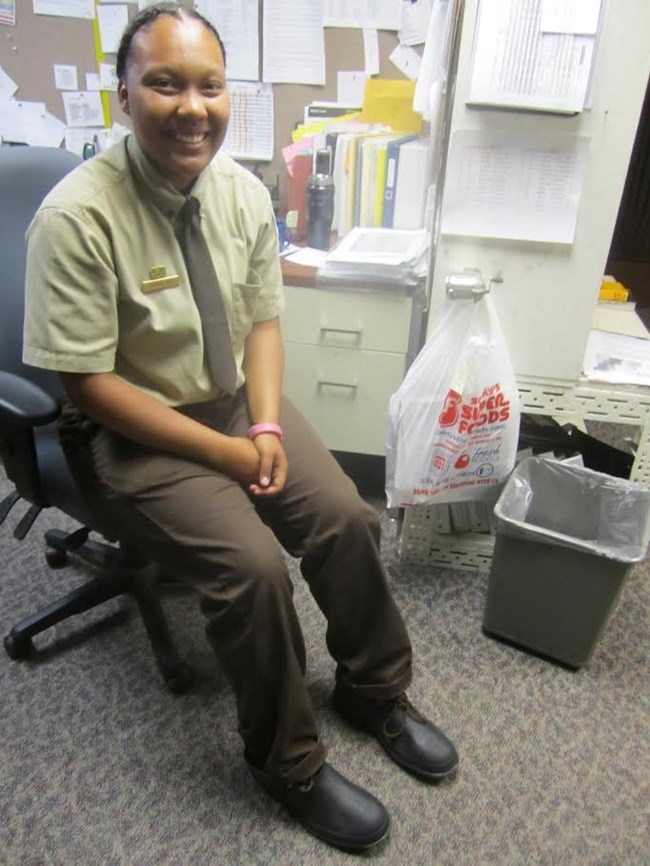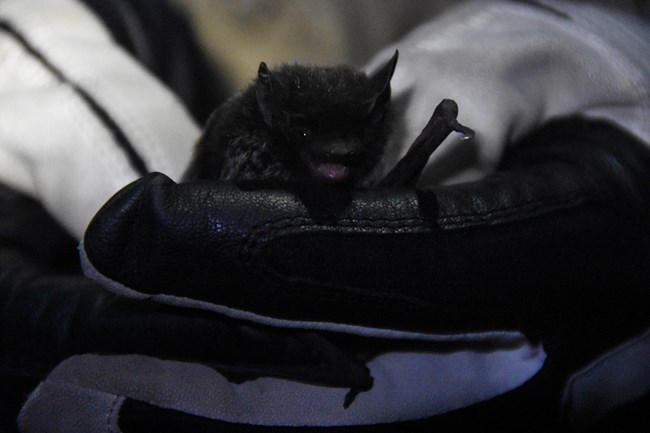Last updated: November 21, 2017
Article
Bat Projects in Parks: Wind Cave National Park
Summary
The 2016 season built upon the groundwork laid by the previous season, with some notable improvements made. Monitoring efforts continued in the same capacity. Twenty four sites were acoustically monitored for at least twenty one days over the course of the season within the park. Additionally, over twenty bat counts were conducted in Wind Cave and various backcountry caves. While the acoustic data is compliant with the new NPSbat database requirements, it still needs to be entered this Winter. To better prevent WNS from being transferred via the public, a number of changes were made to the decontamination protocol. These changes focused on making WNS screening highly visible on various mediums, and decontamination protocols more efficient. As a result, the amount of people screened for WNS has increased by 600% compared to last season, without increasing manpower requirements. For education and outreach, volunteers donated 368 hours of their time to bat work, and the public were educated about bats through evening programs, nature hikes, and school presentations by interpreters and resource management staff.

NPS Photo.
Monitoring Efforts
The second season of bat monitoring at Wind Cave built upon the previous.
Twenty three of the twenty four acoustic monitoring sites that were used in 2015 were reused in the 2016 season. One new site was added. Sites were diverse, with sampling occurring at various elevations, drainages, by flowing and standing water, and near buildings and cave entrances. There was also monitoring in mixed grass prairie, aspen groves, and within coniferous forests. Like the previous season, twenty two sites were monitored for seven days at a time, during the beginning (May-June), middle (July-August) and end (September-October) of the season to get a better image of how bat behavior or use might change over time. Two permanent sites from 2015, which provide continuous monitoring for month long increments, were also re-used. As of September 30 over one terabyte of data has been generated. A very slight increase over last season.
Bat call analysis was preliminary at best for 2016, but the presence of all
twelve bat species found in the park has been confirmed acoustically
through manual review of various deployments. The majority of the data
has been auto-classified, but has not been manually reviewed. Further analysis will also be needed to determine site specific species usage and how bat activity changes over time. Auto-ID outputs from Sonobat will be uploaded to NPSbat, with additional manual vetting when time allows over the winter of 2016-2017. As with all acoustic monitoring, a significant number of calls cannot be used for positive identification of species. Wind Cave will not be using auto-classifiers to make management decisions without manual review by trained experts. All data collected complies with the new NPSbat protocols.
Additionally, two nights of mist netting were repeated at sites used the previous year. One site yielded ten of the twelve species found at Wind Cave in 6 hours. No evidence of white nose was detected. Bat counts were conducted at the natural entrance of Wind Cave twenty three times, or about once a week by trained staff. Bat survey’s at three backcountry caves were also conducted.

NPS Photo.
White-nose Syndrome
Thanks to funding, Wind Cave’s WNS decontamination plan was updated this year to better prevent the spread of this devastating fungus. WNS has been known to be primarily transferred between bats, but it the fungus is also thought to travel on clothing or gear. The previous decontamination procedures were out of date, and cumbersome for rangers, which reduced screening efforts.
The objectives for this new plan was to create a protocol that was highly visible, easy for rangers to implement, and most of all, effective at preventing WNS. These changes were implemented during the parks busiest season since 1972, seeing 123,041 visitors going through the cave (up 18% from last year). As a result of the increase in visitors and the new decontamination protocol, the number of visitors screened between 2015 and 2016 has increased significantly.
Efforts were made to educate the public about WNS prevention before coming to the park through different interpretive mediums. Not bringing clothing and shoes that might be carrying WNS spores is the easiest and most effective way to stop WNS from being brought in by people. The park info AM radio station (TIS-Travelers information System) now talks about WNS and asks visitors to not bring clothing or shoes that have been in other caves. The parks website now displays an alert asking people to not bring clothing that had been in another cave, and there is an updated page which educates visitors about bats and WNS prevention. When calling over the phone, visitors are now notified about WNS screening and what they can and cannot bring for different tours.
At the Visitor Center, there is now a large WNS poster and several other prompts asking visitors to help screen themselves. This was designed during a joint meeting between Wind Cave and Jewel Cave management teams, to ensure a cohesive message was conveyed by both parks. Instructional flow charts and SOP’s were also created for rangers to refer to while screening. To ensure a smooth transition to this new plan, the bat technician conducted one on one trainings with all of the parks interpreters, and a number of rangers from different departments, including the superintendent, on how to screen the public and working through the new protocols. The bat tech also solicited feedback from rangers and WNS researchers to ensure all needs were being met from both sides.
As a result of these changes, the amount of public deconned in 2016 is, at minimum, 600% higher than 2015.
WICA’s decontamination protocols were updated based on the latest guidelines from the USFWS. In addition, the bat technician worked closely with WNS experts (Dr. Michelle Verant) on additional methods to prevent the transfer of WNS to Wind Cave via humans. The decision to implement a boot cover as an option was made from this correspondence.
The boot covers WICA uses effectively isolate the shoe from the cave environment, preventing the transfer of spores if they are still present after the shoe has been thoroughly brushed. For the majority of visitors that are screened, boot covers offer many a viable alternative to a 10 minute solution bath or soaking in hot water for 30 minutes. To address issues with traction, visitors are also given different options, such as disposable non-slip water resistant covers, or a rubber booty used in hazmat operations.
It’s important to note that this is not a one size fits all solution. Boot covers are not an option for any off trail activities, and are not adequate for preventing spore transfer from boots that are covered in mud, or recently used in WNS positive caves (within the last 2 years). They are also not recommended to visitors with stability issues.
Additional testing in other caves has shown that disposable booties are not appropriate options for other caves. The boardwalks on the scenic tour in Jewel Cave tore the booties within 15 minutes of use.
While this is not a factor at Wind Cave, the use of booties in other caves must be thoroughly tested before being implemented. WICA will also be looking into additional research on the fungus to ensure best practices for mitigation are being followed for future seasons. In the future, Wind Cave hopes to comply with a park wide plan for WNS, to ensure a cohesive and effective method to screen visitors between NPS units.

Photo courtesy of South Dakota Public Broadcasting reporter, Michael Zimny.
Education/Outreach and Volunteering
The bat technician travelled to a local elementary school to teach students about bats, using interpretive materials bought with bat funds. A class of twenty five students from Colorado State University also were able to attend a talk on bats and use acoustic monitoring equipment to listen for bats. The bat technician also helped an intern create an evening program about bats, and led evening walks where the public were able to listen and look for bats. In total seventy two public were directly contacted in three evening programs in 2016.
Three park volunteers were trained in acoustic monitoring. They learned about data logger setup and breakdown, data entry and filing, and acoustic monitoring. The technician also spent four days training the seasonal bat technician at Jewel Cave National Monument (SCA intern). In total, six VIP’s donated three hundred and sixty eight hours to bat related work in 2016.
A reporter was able to attend an evening of mist netting bats. He wrote an article in the Science and Technology blog for South Dakota Public broadcasting.
